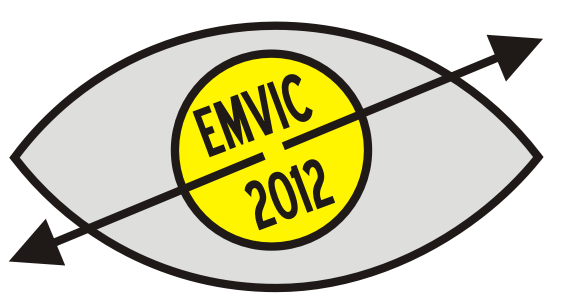 EMVIC 2012
EMVIC 2012The First Eye Movements' Verification and Identification Competition for BTAS 2012 Conference
 EMVIC 2012
EMVIC 2012Proper human identification becomes one of the most important problems in our world. Everybody wants to have easy remote access to different resources like bank accounts, mail servers or social networks profiles. At the same time everybody wants to be sure that no one else will get access to these resources. Traditional identification methods use tokens. The token may be for instance a credit card or a key. The token method has two significant drawbacks. Firstly, it may be lost or stolen. Secondly, the token may be copied. A person, who has somebody’s token, or a copy of it, has automatically an access to all resources of genuine token’s owner. The most popular identification methods are so called memory based methods. They identify people by checking their knowledge. In most cases the 'knowledge' is a secret word - a password. Similarly to token, the password may be stolen. It may also be guessed or broken by malicious impostors. That is why human identification basing on measurement of some properties of the human being - so called biometric identification - becomes more and more popular and important.
The main advantage of biometric identification is that it is more difficult to forge than the classic methods. It is also easy for users – they don’t need to remember or have anything. Another interesting property of biometric identification is that, contrary to classic methods, it enables the so called 'negative identification'. It means that we can identify people who don't want to be identified (like in criminal investigations for instance). Biometric property cannot also be 'borrowed' and stealing it is very difficult and sometimes impossible.
There are a lot of different biometric features that can be measured so there are a lot of potential biometric identification measures. To compare different biometric identification methods we need some criteria. The most important one seems to be distinctiveness of the measurement. It shows how much the specific feature is different for different people. For instance body temperature or shape of the palm are easy to measure but they are not very distinctive – result would be the same for many people.
Another important criteria is repeatability of the method. Repeatable method gives the same results for different trials for the same person. For instance fingerprint may be easily damaged with chemicals or simple injuries. The shape of the face may be easily changed with moustache or glasses. On the other hand, it is rather difficult to change the shape of the palm or iris image.
The most popular biometric identification methods include recognition of people basing on their fingerprint, face and iris pattern. All these methods have the same drawback: only the part of the human body is needed to proper identification. The person being identified may be unconscious or – for some methods – even dead. Moreover, potential forgers may try to prepare models of human body like artificial fingers or contact lenses. The problem is very serious. When somebody steals a credit card it may be blocked. Stolen password may be easily changed. But changing a fingerprint or iris is not so simple.
The problems described above resulted in increased attention paid to methods using not only physiological properties but also measuring the behavioral patterns. Behavioral biometrics is based on measurements of data derived from human action so it always has time component. The main advantage of behavioral biometrics is that it is generally difficult to forge because it is difficult to imitate somebody’s behavior. However, behavioral methods have often low repeatability, because human behavior tends to change. Therefore error rates are higher than for physiological methods and practical usages are so far rare.